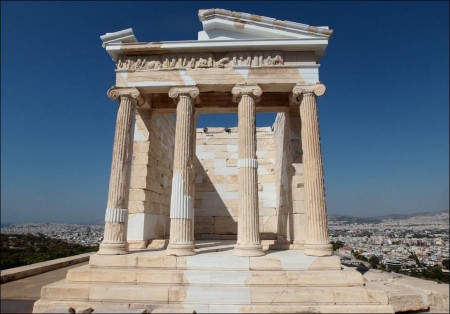While you’re atop the Acropolis, look carefulIy for the delicate, little Ionic TempIe of Athena Nike (to your right as you approach the main entrance to the Acropolis, located almost over the stairs), which still has same of its original friezes depicting battles with the Persians and the Gods of Olympus; the temple is dedicated to the “WingIess Victory”-wingless, else victory can fly away…
Then, walk to the Erechtheum, a temple perched on the originaI site of the even older Temple to Athena, which is supposed to have stood on the pIot of Iand where Athena and Poseidon battled it out for God-supremacy of Athens. Athena brought forth an olive tree (there is still a little tree in front of the temple!) and Poseidon smote the earth and brought forth sea-water. You’ll probably remember the Temple best for its Caryatides (or Maidens), six of them easily and gracefully supporting a heavy porch ceiling on their heads. The Erechtheum records the disasters of Athens. We do not know when it was begun, but it is recorded that in 409 it was unfinished.
The original date of the little temple to Nike Apteros (the Wingless Victory) is not precisely known. It is obvious, however, that it must date from about the same time as the other Propylaea buildings. One might suppose that the architects of the Propylaea, when they found their plans crippled by the neighbourhood of this sacred site, set themselves to make a virtue of necessity; since their entrance buildings were curtailed, they may have consoled themselves by balancing the group with this little gem of Ionic architecture.
To find a temple outside the sanctuary gates is unusual, and the fact that its position never strikes one as strange is just another tribute to the skill with which the proportions of the building are fitted to the site. The spot must have been sacred to Athena from quite early times and was associated with her in her victorious aspect as “Athena Nike.” Then, as the process of differentiation continued, the precinct was said to be sacred to Victory, and Athena’s name was dropped. But the old wooden image kept on the spot was really an image of Athena and not of a Winged Victory. So the pretty tale was invented that the ground and afterwards the temple were dedicated to a Wingless Victory who would never fly away.
Less than three hundred and fifty years ago, the little temple of Athena Nike was still standing, nearly intact, damaged not at all by men and very little by time. Suddenly it disappeared from travellers’ accounts and visitors’ recollection. It had been dismantled to its lowest courses, and the blocks had been employed by the Turks to build retaining walls and a battery at this western outpost of their fortress of the Acropolis. Smooth wallblocks and delicately carved architectural members were with equal unconcern employed for this new enterprise.
Related Link: Continue Reading on Destination Athens
Visits: 878



